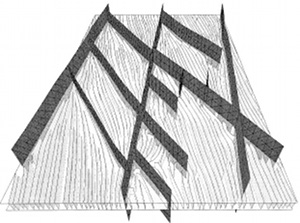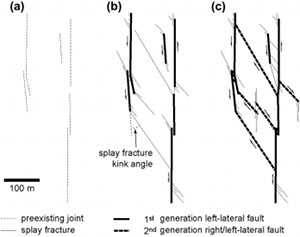| |||||||||
|
|
|||||||||
|
|
|||||||||
| Mechanism and Mechanics of Multiple Strike-slip Fault Sets | |||||||||
|
This topic has been dealt with under various categories. A partial list of them are given in the links below. Two case studies are also included in the list. The related conceptual and mechanical models can be summarized as follows: Conjugate Strike-slip Faults and apparent Conjugate Strike-slip Faults, with the latter being basically sequential shearing under a rotated stress field, again, described in detail at several links provided below. Figure 1 from Rawnsley et al. (1998) among others is a good example for this mechanism.
Figure 2 from Bourne and Willemse (2001) is a model for strike-slip faulting and the related jointing in the same area. Both of these models address primarily fracturing associated with strike-slip faults, but the fractures in the field all have shear displacements primarily in a strike-slip sense. Figure 3 illustrates a similar case of sequential shearing from (a) through (c) at Valley of Fire Nevada (Flodin and Aydin, 2004) with the distinction that the strike-slip faults occur in a hierarchical pattern.
| |||||||||
| Reference: |
|||||||||
| Bourne, S.J., Willemse, E.J.M, 2001 Flodin, E.A., Aydin, A., 2004 Rawnsley, K.D., Peacock, D.C.P., Rives, T., Petit, J.P., 1998 |
|||||||||
|
Readme | About Us | Acknowledgement | How to Cite | Terms of Use | Ⓒ Rock Fracture Knowledgebase |
|||||||||


